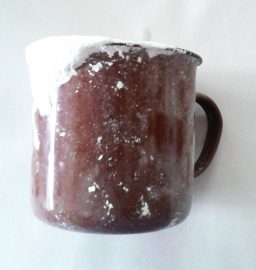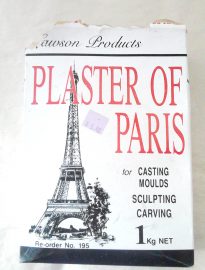Update 2018! Since writing this recipe in 2014, Ive been using this homemade Gesso recipe, for 14 years now and haven’t had an issue, with ageing, layers coming apart, seepage, changes in colour etc. on any of my artworks. I use it with both oil and acrylic paints. I also seal my papers with it when, making books, sewing on paper, paper for collage, painting with paint, inks etc. As to the quality, I find the homemade isn’t as white, but just as good quality, as professional artists Gesso. I also use store bought gesso too, if I’ve run out and for convenience. My version is more gritty, than store bought, but if you sandpaper in between coats, I find it’s not an issue. For me, this recipe is just as good as, the store bought and if you use archival PVA/Elmers glue, it will make it all the more stable, for longevity.
Homemade Gesso!
I love Gesso paint and use heaps of it in my work. It’s gritty, chalky and can be applied to artwork to give a translucent or opaque look. It’s also very expensive so I decided to make my own.
Gesso is used for many things such as a primer for canvas or on paper to give a good base for painting, drawing or mixed media work. When making collage I use it as a gluing medium to stick on papers, in-between, painting and drawing layers.
The recipe below makes 2 litres of Gesso paint
( If not using straight away, this Gesso will last approx. 4-6 weeks)
Homemade Gesso
PLASTER MIX
1 cup Plaster of Paris or fine white plaster powder
1 cup of PVA or white glue (archival if available)
1 cup hot water
PAINT
3 cups white acrylic paint
UTENSILS
Container, cup and mixing stick or spoon
RATIO: 1-3
Plaster Mix 1 – Acrylic paint 3
Method
To make the plaster mix. Add the plaster to the hot water and stir ( Safety purposes: always add the plaster powder to the liquid, not liquid to plaster, as it will blow up into your face and always wear a dust mask)
Dust Mask
“Plaster of Paris” and cup
Hot water and mix
Next add the PVA or white glue, stir.
Finally add the white acrylic paint and mix. ( I used some acrylic powder paint I had and made it up with water) You can use any kind of acrylic paint or colour .
Result
I was very happy with the result. The gesso is translucent with the gritty bits I like. You can also do several layers of gesso to give a more opaque appearance. It covered my canvas very well with only 1 coat. When adding more than 1 coat you can sand in- between to give a really smooth surface for detailed work .
2 litres of Gesso
Gesso on stretched canvas
Gesso on paper
Update 2018! Ive been using this recipe for 14 years now and have had no issues with ageing , seepage. I use it with oil paintings and acrylic artworks. I also seal my papers with it when making books, sewing paper for collage, painting with paint, inks etc.
Tags: acrylic gesso, acrylic primer, Art materials, homemade gesso, how to, how to make gesso, How To's, mixed media, Painting, painting equipment, painting on canvas, Painting Techniques, pigments, supplies, tutorial











great, I will try that. Thanks!
Hi there, I just wanted to ask, how long will this store for? Should you use it all up in one go or will it keep? Thanks
Hi Nasreen, About 4 weeks. So, if your not using it straight away, I would only make it in small amounts.
Hello,
I have questions about glue that use in the gesso making, I just bought a bottle glue in art store, it say pvca on the bottle.
I don’t know if there is difference between pva and pvca, and it is ok to use pvca in gesso making?
I was wondering if you if you could use ceramic plaster instead of Plaster of Paris? I want to make my own gesso because I ran out of the amount I had while putting it on a canvas I am working on. I did not even get a fourth of it covered. Also for the amount I need I think it would be cheaper to make my own gesso. I have everything needed but Plaster of Paris. But I do have Ceramic Plaster. Will that work?
Ive never heard of ceramic plaster… I would try it on a sample canvas first and would love to hear how you go if you try it.
Ceramic plaster is similar to Plaster of Paris in a lot of ways, but slower setting and the end result isn’t as fragile as Plaster of Paris.
It’s often used for things like making statues, making moulds for ceramics, various casting things. (similar to Plaster of Paris, but more specialised ;>)
And yeah, it’d probably work. Probably… 😉
Was really curious to know weather ceramic plaster worked?
I haven’t tried it myself but…I’m sure ceramic plaster would work. Though it might take longer to dry on canvas as in previous answers:)
Thanks for this Rachel
I found this very effective as a sandable/ textured finish over paper mâché. It’s easier to spread than I thought it would be, and it’s strong!
I don’t think these comments are getting through, I’ll email you as well
Thanks Rachel! That’s great to know, sounds like its pretty tough. I’ll have to experiment with it too 🙂
Thanks for this ‘recipe’. I’m going to give it go, as gesso is so expensive to buy. I’ve bookmarked the page!
Yes, it can be very expensive and this recipe makes quite a lot:)
I was looking for a homemade gesso and came across your recipe. I have just one question. While looking I have seen some sites that say that pva glue makes a painting or other artwork non archival. Do you know if this is correct or not? It’s just that ever recipe I’ve come across for making your own gesso uses it. I don’t know if the commercially produced ones do, who knows what’s in them… But they are just way too expensive for the amounts that most people would use, in my opinion anyway. Also, if they use similar ingredients to the homemade ones then why are they so expensive?
Hi Angela, Good question…Ordinary PVA is not archival but, you can buy archival PVA glue. Just google “Archival PVA Glue” for stockists.
A further note, though this topic is a few years old now: I once used PVA glue to adhere canvas or muslin to hardboard in making my own panels for painting. However, the PVA glue partially “reactivates” — softens — when wetted, so when painted with acrylic paint, the fabric would often blister up from the hardboard where spots of PVA glue softened and released. I switched to using acrylic gel as a glue, and the problem was solved. All the commercial gesso I have purchased is “acrylic gesso”, which is formulated with acrylic resin and not PVA glue. For what it’s worth…
Thanks for the further information Donald. Interesting…
Thank you, that’s very interesting and will try acrylic gel.
Hi Ms. Davis,
Do you use this gesso on all of your paintings? Because paint wasn’t my dominate medium I never learned the ins and outs of preserving canvas. (I’ve never prepped a canvas). From what I’ve I learned, I assume that a high quality varnish will preserve my acrylic paintings on canvas prepared with this homemade gesso? (I did buy Plaster of Paris after learning about this type of recipe, however I am not familiar with it, I am learning).
Thank You
Hi Demetria, Yes, I do use Gesso to prime all my canvas’s. I also, sometimes use a clear vanish or medium, on to top of my paintings to seal. Acrylic paint doesn’t need to be sealed, but sometimes it will bring out the colours more.
after creating your painting we put out from the frame for sale or for any other reason..does it effect on the painting if we rolled it? i m using primer canvas..does is still require for any effect on my painting such as for opaque or abstract ….
Rolling up acrylic or oil paintings wont effect them as long as, your paintings are all thoroughly dry.
About 15 years ago I bought a dollshouse of the type made of thin ply wood which slotted together. I kitbashed it by cutting off the tabs for the slots and glueing it together before covering it with my own homemade gesso. I used emulsion paint, pva glue and a little polyfilla! The result is still solid, no sign of deterioration at all. Hope this helps anyone with misgivings about the sustainability of homemade gesso.
Hi Marian, Thanks heaps for your feedback and sharing your results about homemade gesso. Its great to know homemade gesso lasts that long and will try adding pollyfila too, Great idea!
Hi Jenny
Thanks for your recipe!
I paint with acrylic and i use gesso to seal the canvas.
I want to try your recipe for gesso, but I wonder if i can use a mixture of flour and salt instead of plaster.
I understood that the result is a pleasant material to work with and also does its sealing work well.
But what happens to it after a year, for example?
do you have any idea?
Hi Ofira,
Thanks for the contact.
I would try the flour and salt and just experiment. Ive never used it myself. As to your question about the gesso lasting … please see my 2018 gesso update here!
Thank you for the post! However if anybody is wanting to make something like a collograph plate, or something thicker in application than priming a canvas, ALWAYS use marble dust, and nothing else. Plaster will crack and fall off if you pile it onto masonite, or hardboard. 😉
Hi Loren, Thank you for the info. I didn’t know that…As I only use gesso for painting, priming a canvas, paper etc. Can I please share this in my post ? Cheers Jenny
Can this mixture be used on Masonite?
Yes, it would definitely seal Masonite.
Thank you for this. I got the stuff today so will try it very soon 🙂
thank you , I’ll gather up the ingredients and follow your advice
the best
dennis
I made an antler mount out of plaster of paris and wanted to paint it. I got some acrylic paint, but i didnt know you had to prime the plaster of paris. Would this gesso work for my project ?
Yes, Gesso would work very well.
I am a little confused by your recipe. you give amounts in one and 3 cup proportions, then say to use in a 1-3 ratio. does that mean in your recipe to use 9 cups of paint? or just the 3?
Hi James, sorry about the confusion. No its not 9 cups paint. Add 3 cups of paint to the plaster mix. Hope this helps. Cheers jenny
PLASTER MIX
1 cup Plaster of Paris or fine white plaster powder
1 cup of PVA or white glue (archival if available)
1 cup hot water
PAINT
3 cups white acrylic paint